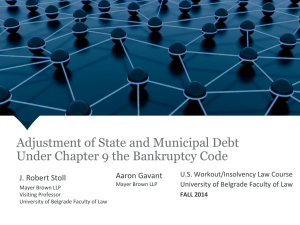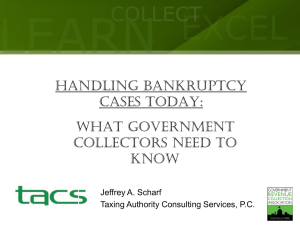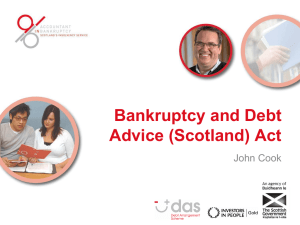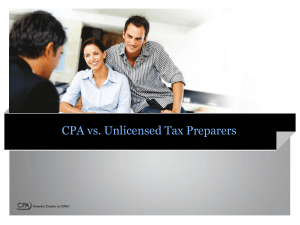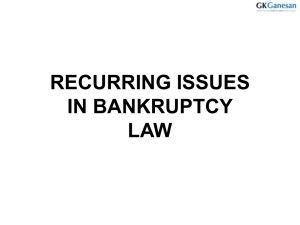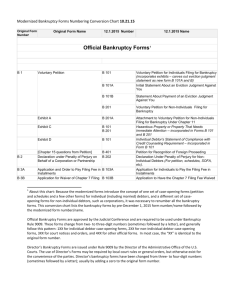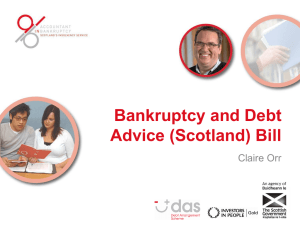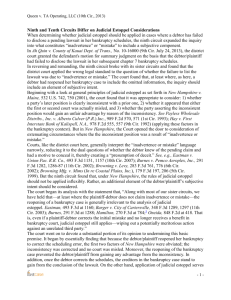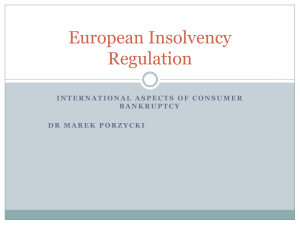Chapter Seven. Overview of Chapter 7
advertisement
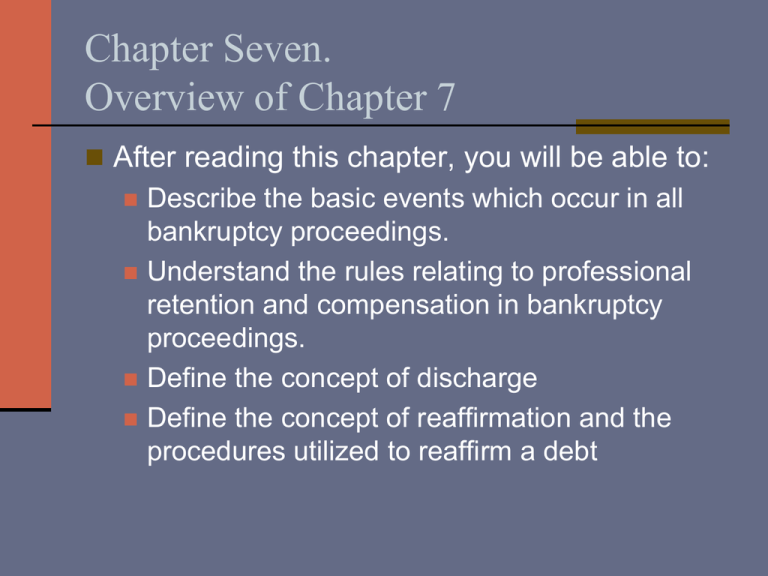
Chapter Seven. Overview of Chapter 7 After reading this chapter, you will be able to: Describe the basic events which occur in all bankruptcy proceedings. Understand the rules relating to professional retention and compensation in bankruptcy proceedings. Define the concept of discharge Define the concept of reaffirmation and the procedures utilized to reaffirm a debt Consumer No Asset Chapter 7 Proceeding A consumer no asset Chapter 7 proceeding is a proceeding filed by an individual debtor or joint debtors in which there will normally be no assets available for the trustee to administer for distribution of dividends to unsecured creditors. Any assets owned by the debtor will be either secured or exempt. Practice Pointer The Bankruptcy Code describes ‘‘joint debtors’’ as an individual debtor ‘‘and such individual’s spouse.’’ The Code recognizes married couples but no other joint filings. Employment and Compensation of Professionals The Bankruptcy Code regulates the employment and compensation of professionals rendering services in any bankruptcy proceeding. Bankruptcy Petition Preparers Section 110(a) defines a bankruptcy petition preparer as a person other than the debtor’s attorney or the attorney’s employee under that attorney’s direct supervision who prepares for compensation a document for filing with the Bankruptcy Court. An unsupervised paralegal may be a bankruptcy petition preparer. A document for filing is any document prepared for filing by a debtor in a bankruptcy case. Exempt Exemptions are statutorily defined property that an individual debtor may protect from administration by a bankruptcy estate. Exempt property is not available for liquidation to pay a dividend to creditors; a debtor may keep exempt property. Exemptions are a primary element of debtor relief. Discharge Discharge is legal relief from debt provided for by Section 524 of the Bankruptcy Code. The discharge is one of the three elements of debtor relief provided for in the Bankruptcy Code. Automatic Stay Automatic Stay is a statutory bar to the conducting of any collection activity by creditors after a bankruptcy petition has been filed. The automatic stay is one of the three major elements of debtor relief provided by the Bankruptcy Code. Fresh Start “Fresh Start” is the phrase most frequently used colloquially to describe the basic elements of debtor relief: Discharge Exemptions Automatic Stay Eight Basic Requirements for Bankruptcy Petition Preparers The preparer must sign the document and include the preparer’s name and address. Provide a notice to the debtor, prior to the preparation of any document, stating that a petition preparer may not give legal advice. The preparer shall include the preparer’s Social Security number on the document. The preparer shall furnish the debtor with a copy of the document not later than the time the document is presented to the debtor for signature. Slide 1 of 2 Eight Basic Requirements for Bankruptcy Petition Preparers The preparer shall not execute any document on behalf of a debtor. The preparer shall not use the word “legal” or any other similar term in advertisements or advertise under any “legal” category. The preparer may not receive or collect payment for court fees. The preparer shall, within ten days after filing of a petition, file a declaration under penalty of perjury disclosing any fees paid or promised by or on behalf of the debtor. Slide 2 of 2 Reaffirmation Reaffirmation is a debtor’s agreement to remain legally liable for repayment of a debt otherwise dischargeable in a bankruptcy proceeding. For a debt to be legally reaffirmed, strict compliance with the provisions of Bankruptcy Code Section 524 is required.

